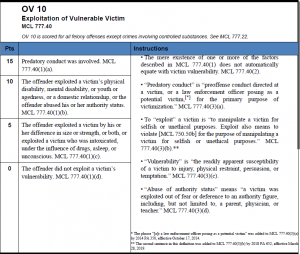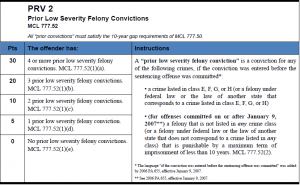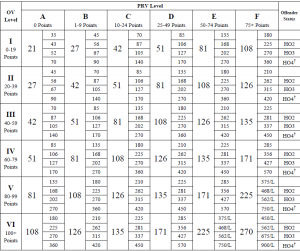Search
Michigan Sentencing Guidelines Under MCL 769.34
If you have been charged with and convicted of a felony in Michigan, then you are probably wondering if you will go to jail, and for how long. One of the most important factors are the Michigan Sentencing Guidelines. All parties involved with your case will utilize the sentencing guidelines in determining an appropriate sentence for you. Because of this, it is important for you to know and understand the sentencing guidelines.
If you have been charged with a federal crime, then see our companion article: What Are the Federal Sentencing Guidelines? For information on jail time on DUI cases see this article: DUI Jail Penalties.
The History of the Michigan Sentencing Guidelines
The current incarnation of the Michigan Sentencing Guidelines was preceded by voluntary Judicial guidelines. The judicial guidelines primarily focused on disparity. The Judicial guidelines were never intended to decide the “right” sentence. Instead, the goal was to “rein in” outlier judges whose sentences were above or below the average for similar offenses and defendants.[1]
Then, in 1998 the Michigan Legislature enacted its own version of sentencing guidelines. In the Michigan Sentencing Guidelines Manual, all felonies are ranked in a total of 9 levels of offense severity. As might be expected, the highest is second-degree murder, which was placed in a class by itself. The remaining felonies are ranked in class A through class H. The classes represent offense severity in descending order, with H being considered the least serious, as follows:
- Class A: Life in prison (or any term of years).
- Class B: Up to 20 years in prison.
- Class C: Up to 15 years in prison.
- Class D: Up to 10 years in prison.
- Class E: Up to 5 years in prison.
- Class F: Up to 4 years in prison.
- Class G: Up to 2 years in prison.
- Class H: Jail or other sanctions.
- Note that aggravated CSAM is an anomaly because it is punishable by up to 10 years, but is a Class B crime.
Additionally, the guidelines reflect Legislative and sentencing public policy. For example, offenses against a person are treated more severely by placement in higher crime class. Since 1998, the guidelines have been frequently amended. Also, certain aspects of the guidelines related to Judicial fact-finding have been found to be unconstitutional.[2]
Also, in 2015, the Michigan Supreme Court rendered the previously mandatory sentencing guidelines “advisory only.” Although “sentencing courts are no longer bound by the applicable sentencing guidelines range,” they must “continue to consult the applicable guidelines range and take it into account when imposing a sentence,” and they “must justify the sentence imposed in order to facilitate appellate review.”[3]
Although the guidelines are advisory, there are nearly always followed closely by judges when determining the appropriate sentence. This is because a sentence that departs from the applicable guidelines range will be reviewed by an appellate court for reasonableness and resentencing will be required when a sentence is determined to be unreasonable.[4]
The proper inquiry when reviewing a sentence for reasonableness is whether the trial court abused its discretion by violating the ‘principle of proportionality’[5] which requires sentences imposed by the trial court to be proportionate to the seriousness of the circumstances surrounding the offense and the offender.[6]
From a historical perspective, sentencing guidelines were intended to accomplish several things, one of which was to remove the possibility of discriminatory sentences. Because there is a certain amount of objectivity to the calculation of sentencing guidelines, a wealthy white male should be sentenced in the same range as a poor black woman.
How Do Sentencing Guidelines Work?
Generally speaking, each offense category has assigned to it a variety of offense variables and prior record variables. Points are assigned for each of these variables, tallied, and then applied to the appropriate sentencing grid. The results of both will cause your sentence to “land” within a particular cell that will dictate the appropriate minimum sentence.
All parties involved with your case will utilize these guidelines, including the judge, the probation officer, the prosecuting attorney, and your lawyer. If there is a failure to agree on how any of the various guidelines points should be scored then arguments for or against scoring these points will be made at or before sentencing, and the sentencing judge will decide how to resolve the discrepancies. Otherwise, the judge will use the agreed upon guidelines in determining the correct minimum sentence in your case. Sentencing guidelines do not dictate maximum sentences because the maximum sentence is set forth in the applicable statute.
Based on changes in Michigan law, guidelines are now considered “advisory” meaning they are no longer mandatory. A judge is free to sentence you within above or below the guideline range. Before you plead guilty your lawyer should discuss all of this with the judge so that you have a good idea of what kind of sentence you’re looking at before you enter your plea. If possible, a Cobbs agreement should be pursued. A Cobbs agreement will allow you to withdraw your plea and stand trial if the judge fails to give you the sentence promised when you tendered your plea.
How to Calculate Offense Variables
Your sentence guidelines will be dictated by a combination of your offense variables and prior record variables. Your offense variables are based on the specific facts of your case, and these are usually adduced using the police reports, or if there was a trial, possibly trial testimony as well. Here is a sample of offense variable ten for the “crimes against person” category.  As you can see, points are assigned for the exploitation of a victim’s vulnerability. This might apply for example in a sexual assault case that includes facts of such exploitation. Points are assigned based on those facts as set forth in this offense variable. There are several other offense variables for this same crime category, and the tally will require an assessment of each.
As you can see, points are assigned for the exploitation of a victim’s vulnerability. This might apply for example in a sexual assault case that includes facts of such exploitation. Points are assigned based on those facts as set forth in this offense variable. There are several other offense variables for this same crime category, and the tally will require an assessment of each.
Depending on the circumstances, case law may need to be consulted to determine if certain points should be scored. As it relates to offense variables, if you stood trial, then certain case law suggests that all facts used in guidelines calculations must have been proved, beyond a reasonable doubt, by the prosecutor at trial.
How to Calculate Prior Record Variables
Prior record variables work the same way as offense variables, except, as is obvious from the name, the points are based primarily on your prior criminal record. To calculate your prior offense variables, your criminal history is utilized and all prior crimes are assessed. Then, you are assigned points depending on if your prior crimes are high severity or low severity, and whether the prior offenses are misdemeanors or felonies. Certain time limits may also apply, and there are also other circumstances under which prior crimes are not properly utilized to assign points. 
In addition to your prior criminal history, there are many other factors considering in assessing assignable points based on various prior record variables. These includes things such as as your relationship to the criminal justice system, whether this crime is a pattern of criminal behavior, and whether you have subsequent or concurrent convictions. All of these points are then tallied, placing you into an A – F level. The range begins at zero points and stops at 75+ points. After 75 points are no longer tallied.
What About Minimum Mandatory Sentences?
Complicating things further, some offenses have minimum mandatory sentences and these are not reflected in the guidelines. A minimum mandatory sentence is just what it sounds like, the minimum sentence you must serve, regardless of the circumstances, for the crime you have committed. Minimum mandatory sentences are set forth in statutes.
A common example of a felony crime with a minimum mandatory in Michigan is felony drunk driving. According to the law, for a third offense DUI with no habitual enhancement the maximum sentence is 5 years. However, for every third offense DUI felony case, there is a minimum mandatory 30 days. Those who are not familiar with these calculations might be confused and provide improper advice because it is not unusual for a felony DUI with no habitual enhancement to have a sentencing guideline range of either 0-6 or 0-9 months. Because of the minimum mandatory however, a sentence of 0 months is not really an option. This may change for some offenders based on an amendment to Michigan’s drunk driving laws. This change to Michigan’s drunk driving laws, which can be found at Michigan Compiled Laws sec. 257.625, allows some repeat drunk drivers in Michigan to avoid minimum mandatory sentences. If you are charged with felony drunk driving, then contact the Michigan DUI lawyers at the Barone Defense Firm to learn if this updated law applies to your situation.
What About Habitual Enhancement?
If you are facing sentencing on a felony offense, and have prior felony convictions (or attempts to commit felonies), those prior felonies can subject you to habitual enhancement. In order for this to happen the prosecutor must serve you or your attorney with a habitual offender notice. This is usually provided, along with a copy of the felony information, at the circuit court arraignment. If you are charged as a habitual offender this raises both the minimum as well as the maximum possible sentence.
Habitual enhancement begins at habitual offender second for one prior felony conviction, and goes up to habitual offender 4 for three or more prior felony convictions. A habitual offender enhancement will increase your maximum sentence by either 25 percent for habitual offender 2nd, 50 percent for habitual offender third or 100 percent/life for habitual offender fourth.
What Will My Sentence Be?
Once all the points are tallied, the sentencing grids are consulted. As with offense variables and prior record variables, there are various grids, and which is utilized depends on the type of crime for which you have been convicted. Here is a sentencing guidelines grid utilized for class A felonies.
As you can see, if this was the appropriate grid for your case, and your guidelines calculation produces a result in the C-II category, your minimum sentence will fall into the range of 51-85 months. If you are a habitual offender, then the minimum would be 51-106, and so forth. You should discuss all of this with your lawyer and then use this information in deciding if it is in your best interest to plead guilty or stand trial. A proper calculation of your offense variables is essential.
Why an Attorney is Important
The application of the Michigan sentencing guidelines to a particular case is complicated and sometimes difficult. A full explanation of how the guidelines work and how they should be applied would require writing a book with many chapters and hundreds of pages. Consequently, this article is a very watered down explanation of how the sentencing guidelines work. There are other factors that might apply, and there is often much debate as to whether some offense or prior record variables should be scored.
If the scoring of certain points is debatable, a skillful defense attorney may be able to persuade your judge to forgo applying those points to your sentence guideline calculation. Also, it is sometimes possible, as part of plea negotiations, for your attorney to persuade the prosecutor to agree not to score certain points. If successful, either modification to the guidelines scoring may result in a significantly lower calculation, saving you months or even years spent in jail or prison. On the other hand, a sloppy or even negligent guideline calculation, or one that misses possible arguments or defenses, can result in needless time spent behind bars.
There are many ways to mitigate a sentence. For see “how we were able to keep a fifth offense felony drunk driver out of jail.”

______________
[1] A subsequent legislative analysis noted: “The [judicial sentencing] guidelines were designed to reduce disparity in sentencing from county to county and region to region by mirroring the existing sentencing practices of judges across the state at the time the guidelines were implemented. They were developed using the results of research on sentencing patterns of judges throughout Michigan, and attempt to capture the typical sentence for similar types of offenses and offenders.” House Legislative Analysis, SB 826, HB 5419, and HB 5398 (Revised Second Analysis), September 23, 1998, 2.
[2] See, People v. Lockridge, 498 Mich. 358, 870 N.W.2d 502 (2015).
[3] Lockridge, 498 Mich at 392, citing People v Coles, 417 Mich 523, 549 (1983).
[4] [4] Steanhouse II, 500 Mich at 459-460, 473, aff’g in part and rev’g in part 313 Mich App 1 (2015).
[5] As set forth in People v Milbourn, 435 Mich 630, 636 (1990)], [and reaffirmed in People v Babcock, 469 Mich 247 (2003), and People v Smith, 482 Mich 292, 304-305 (2008),
[6] Id.
 Michigan Criminal Defense Lawyer Blog
Michigan Criminal Defense Lawyer Blog

